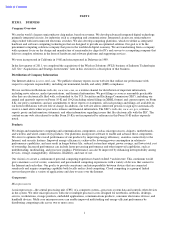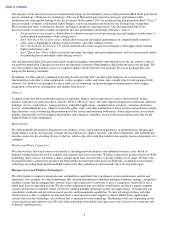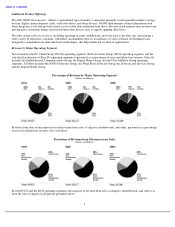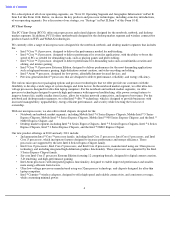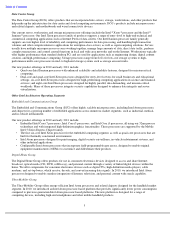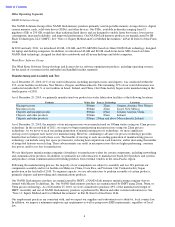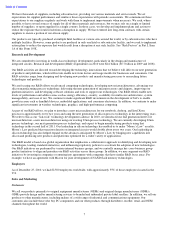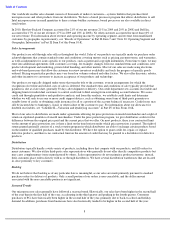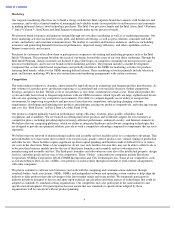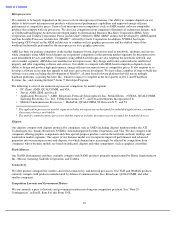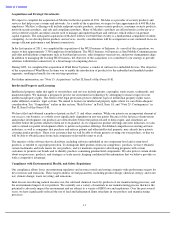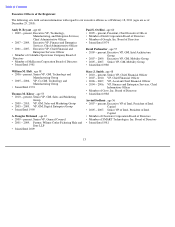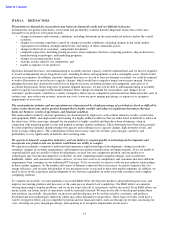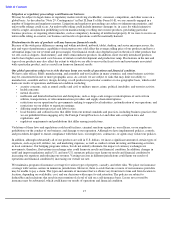Intel 2010 Annual Report Download - page 15
Download and view the complete annual report
Please find page 15 of the 2010 Intel annual report below. You can navigate through the pages in the report by either clicking on the pages listed below, or by using the keyword search tool below to find specific information within the annual report.
Table of Contents
We have thousands of suppliers, including subcontractors, providing our various materials and service needs. We set
expectations for supplier performance and reinforce those expectations with periodic assessments. We communicate those
expectations to our suppliers regularly and work with them to implement improvements when necessary. We seek, where
possible, to have several sources of supply for all of these materials and resources, but we may rely on a single or limited
number of suppliers, or upon suppliers in a single country. In those cases, we develop and implement plans and actions to
reduce the exposure that would result from a disruption in supply. We have entered into long-term contracts with certain
suppliers to ensure a portion of our silicon supply.
Our products are typically produced at multiple Intel facilities at various sites around the world, or by subcontractors who have
multiple facilities. However, some products are produced in only one Intel or subcontractor facility, and we seek to implement
action plans to reduce the exposure that would result from a disruption at any such facility. See “Risk Factors” in Part I, Item
1A of this Form 10-K.
Research and Development
We are committed to investing in world-class technology development, particularly in the design and manufacture of
integrated circuits. Research and development (R&D) expenditures in 2010 were $6.6 billion ($5.7 billion in 2009 and 2008).
Our R&D activities are directed toward developing the technology innovations that we believe will deliver our next generation
of products and platforms, which will in turn enable new form factors and usage models for businesses and consumers. Our
R&D activities range from designing and developing new products and manufacturing processes to researching future
technologies and products.
We are focusing our R&D efforts on advanced computing technologies, developing new microarchitectures, advancing our
silicon manufacturing process technology, delivering the next generation of microprocessors and chipsets, improving our
platform initiatives, and developing software solutions and tools to support our technologies. Our R&D efforts enable new
levels of performance and address areas such as energy efficiency, security, scalability for multi-core architectures, system
manageability, and ease of use. We continue to make significant R&D investments in the development of SoCs to enable
growth in areas such as handheld devices, embedded applications, and consumer electronics. In addition, we continue to make
significant investments in wireless technologies, graphics, and high-performance computing.
As part of our R&D efforts, we plan to introduce a new microarchitecture for our notebook, desktop, and Intel Xeon
processors approximately every two years and ramp the next generation of silicon process technology in the intervening years.
We refer to this as our “tick-tock” technology development cadence. In 2010, we introduced our 2nd generation Intel Core
microarchitecture, a new microarchitecture using our existing 32nm process technology. We are currently developing 22nm
process technology, our next-generation process technology, and expect to begin manufacturing products using that
technology in the second half of 2011. Our leadership in silicon technology has enabled us to make “Moore’s Law” a reality.
Moore’s Law predicted that transistor density on integrated circuits would double about every two years. Our leadership in
silicon technology has also helped expand on the advances anticipated by Moore’s Law by bringing new capabilities into
silicon and producing new products and platforms optimized for a wider variety of applications.
Our R&D model is based on a global organization that emphasizes a collaborative approach to identifying and developing new
technologies, leading standards initiatives, and influencing regulatory policies to accelerate the adoption of new technologies.
Our R&D initiatives are performed by various internal business groups, and we centrally manage key cross-business group
product initiatives to align and prioritize our R&D activities across these groups. In addition, we may augment our R&D
initiatives by investing in companies or entering into agreements with companies that have similar R&D focus areas. For
example, we have an agreement with Micron for joint development of NAND flash memory technologies.
Employees
As of December 25, 2010, we had 82,500 employees worldwide, with approximately 55% of those employees located in the
U.S.
Sales and Marketing
Customers
We sell our products primarily to original equipment manufacturers (OEMs) and original design manufacturers (ODMs).
ODMs provide design and/or manufacturing services to branded and unbranded private-label resellers. In addition, we sell our
products to other manufacturers, including makers of a wide range of industrial and communications equipment. Our
customers also include those who buy PC components and our other products through distributor, reseller, retail, and OEM
channels throughout the world.
7



